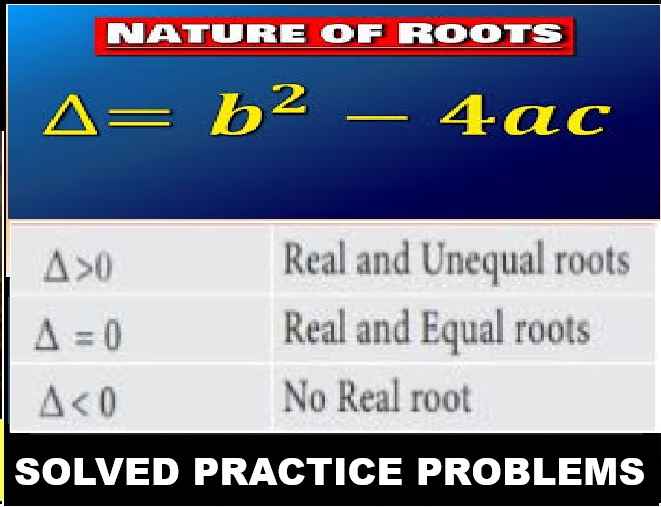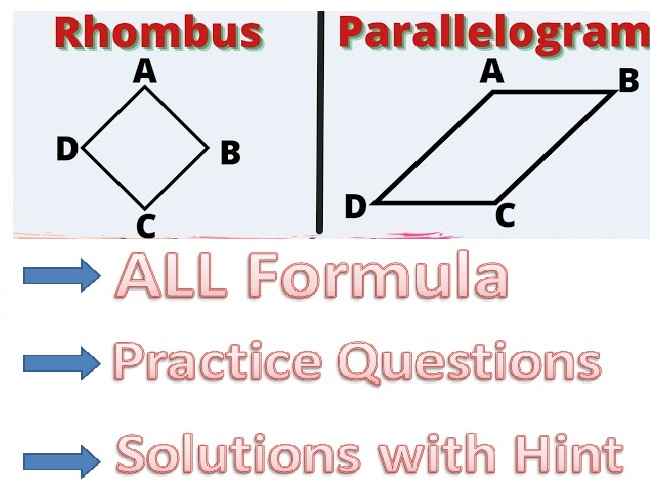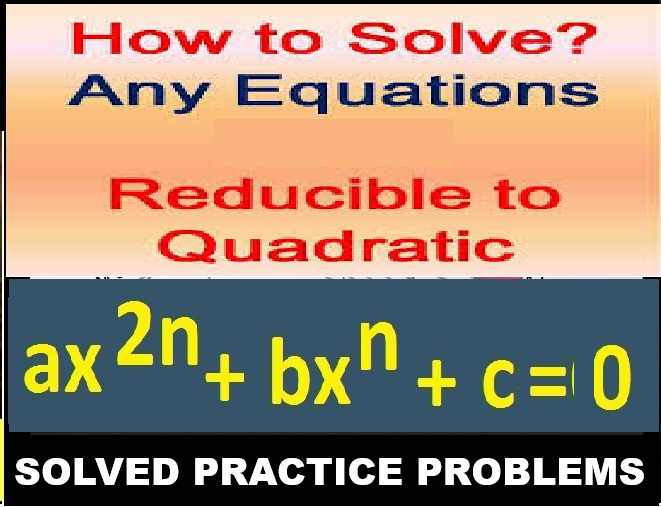Sense Organs ICSE Class-10 Concise Selina Biology Solutions Chapter-11 . We Provide Step by Step Answer of Progress Check , MCQs, Very Short Answer Type, Short Answer Type, Descriptive Answer Type Questions and Structured / Applications / Skill Type Questions of Exercise-11 Sense Organs ICSE Class-10 . Visit official Website CISCE for detail information about ICSE Board Class-10.
| Board | ICSE |
| Publications | Selina Publishers PVT LTD |
| Subject | Concise Biology |
| Class | 10th |
| writer | HS Vishnoi |
| Chapter-11 | Sense Organs |
| Topics | Solutions of MCQs, Very Short ,Descriptive and Structural/Skill Questions and Progress check |
| Edition | 2021-2022 |
Sense Organs ICSE Class-10 Concise Selina Biology Solutions Chapter-11
-: Select Topics :-
E. Structured /Application /Skill Type ,
A. MULTIPLE CHOICE TYPE
Sense Organs ICSE Class-10 Selina Concise Biology
Page 148
Question 1
Which part of the eye is grafted in a needy patient from a donated eye?
(a) Conjunctiva
(b) Cornea
(c) Choroid
(d) Ciliary muscles
Answer 1
(b) Cornea
Question 2
Which part of our ear is shaped like a snail shell?
(a) Semi-circular canals
(b) Cochlea
(c) Stapes
(d) Eustachian tube
Answer 2
(b) Cochlea
Question 3
The three parts of human ear contributing in hearing are:-
(a) Cochlea, ear ossicles and tympanum
(b) Semi-circular canals, utriculus and sacculus
(c) Eustachian tube, tympanum and utriculus
(d) Perilymph, ear ossicles and semi-circular canals
Answer 3
(c) Eustachian tube, tympanum and utriculus
Question 4
The region in the eye where the rods and cones are located is the
(a) Retina
(b) Cornea
(c) Choroid
(d) Sclera
Answer 4
(a) Retina
B. VERY SHORT ANSWER TYPE
Chapter-11 Sense Organs for ICSE Class-10 Concise Biology Selina Publishers
Page 148-149
Question 1
Name the following:
(a) The photosensitive pigment present in the rods of the retina.
(b) The part which equalizes the air pressure in the middle and external ear.
(c) The ear ossicle attached to the tympanum.
(d) The tube which connects the cavity of the middle ear with the throat.
(e) The part of the eye responsible for its shape.
(f) The nerves which transmit impulse from ear to the brain.
(g) The photoreceptors found in the retina of the eye.
(h) The eye defect caused due to shortening of the eye ball from front to back.
Answer 1
(a) Rhodopsin
(b) Eustachian tube
(c) Hammer
(d) Dura mater
(e) Eustachian tube
(f) Cornea
(g) Auditory nerves
(h) Rods and cones
(i) Hypermetropia
Question 2
Note the relationship between the first two words and suggest the suitable word/words for the fourth place.
(a) Cones: Iodopsin:: rods: ________.
(b) Sound: ear drum:: dynamic balance: __________.
Answer 2
(a) Cones: Iodopsin:: rods: rhodopsin
(b) Sound: ear drum:: dynamic balance: semi-circular canals
Question 3
Which one or more of the expressions in column II are appropriate for the items listed in column I? Match the correct pairs:
| Column I | Column II |
| i. The blind spot | (a) colour of the eye |
| ii. The yellow spot | (b) shape of the lens |
| iii. Ciliary muscle | (c) amount of light entering the eye |
| iv. Iris | (d) maximum sensory cells |
| v. Pupil | (e) no sensory cells |
Answer 3
| Column I | Column II |
| i. The blind spot | (e) no sensory cells |
| ii. The yellow spot | (d) maximum sensory cells |
| iii. Ciliary muscle | (b) shape of the lens |
| iv. Iris | (a) colour of the eye |
| v. Pupil | (c) amount of light entering the eye |
C. SHORT ANSWER TYPE
Chapter -11 Sense Organs Solutions
Page 149
Question 1
State whether the following statements are true (T) or false (F). If false, correct it by changing any one single word.
(a) Deafness is caused due to rupturing of the pinna.(T/F)
(b) Semicircular canals are concerned with static (positional) balance. (T/F)
Answer 1
((a) False
Correct statement : Deafness is caused due to rupturing of the eardrum.
(b) False
Correct statement : Semicircular canals are concerned with dynamic balance.
Question 2
Where are the following located? State their main functions :
(a) Yellow spot
(b) Lacrimal gland
(c) Organ of Corti
(d) Semicircular canal
(e) Oval window
(f) Utriculus
Answer 2
(a) Yellow spot : lies at the back of the eye almost at the centre on the horizontal axis of the eyeball. It is the region of brightest vision and also of colour vision.
(b) Lacrimalglands : are located at the upper sideward portion of the eye orbit. They pour the secretion in the form of tears which serves as a lubricant, antiseptic and even washes away dust particles from the eyes.
(c) rgan ofCorti : is present in the middle cochlear canal of the ear. It helps in hearing.
(d) Semicircular : canals are located in the inner ear. These help in maintaining the dynamic equilibrium of the body.
(e) Ovalwindow : is located in the middle ear. It helps in setting the fluid in the cochlear canals into vibration.
(f) Utriculus : is located in the inner ear. It joins the semi-circular canals to cochlea. It also helps in maintaining static balance of the body.
Question 3
Given below are two sets (a) and (b) of five parts in each. Rewrite them in correct sequence.
(a) Cochlea, tympanum, auditory canal, ear ossicles, oval window
(b) Conjunctiva, retina, cornea, optic nerve, lens
Answer 3
(a) Auditory canal, tympanum, ear ossicles, oval window, cochlea
(b) Conjunctiva, cornea, lens, retina, optic nerve
Question 4
Given below are certain structures. Write against each their specific functional activity.
(a) Cochlea
(b) Auditory nerve
(c) Retina
(d) Choroid
(e) Sacculus
Answer 4
(a) Cochlea : Cochlea contains organ of Corti which contains sensory cells for hearing. They transmit sound impulses to the brain through auditory nerve.
(b) Auditory nerve : It is the main nerve formed by nerve fibres arising from the sensory cells present in cochlea. This nerve carries sound impulses from inner ear to the brain.
(c) Retina : It is the innermost layer of eye which is sensitive to light. Retina forms the image of an object seen by the eyes.
(d) Choroid : It is middle vascular layer of the eyeball. Choroid provides nourishment to the eye.
(e) Sacculus : It is a part of semicircular canals of the inner ear. It contains sensory cells called macula which help in
Question 5
Complete the following table by filling in the blank spaces.
| Structure | Function |
| 1. ……………………. | (i) Transfers impulse from inner ear to brain |
| 2. ……………………. | (ii) Helps to change the focal length of the eye lens |
| 3. ……………………. | (iii) Dynamic equilibrium |
Answer 5
Complete the following table by filling in the blank spaces.
| Structure | Function |
| 1. Auditory nerve | (i) Transfers impulse from inner ear to brain |
| 2. Ciliary muscle | (ii) Helps to change the focal length of the eye lens |
| 3. semicircular canals | (iii) Dynamic equilibrium |
Question 6
Name the following:
(a) Two pigments of the sensory cells.
(b) Two types of adaptations.
(c) Two kinds of accommodations.
(d) Three layers of the eyeball.
Answer 6
(a) Rhodopsin and iodopsin.
(b) Dark adaptation and light adaptation.
(c) Distant vision accommodation and near vision accommodation.
(d) Sclera, choroid and retina.
Question 7
Name the eye defects caused due to each of the following:
| Cause | Eye defect |
| (a) Lens turns opaque | ……………………….. |
| (b) Uneven curvature of the cornea | ……………………….. |
| (c) Deficiency of vitamin A | ……………………….. |
| (d) Lens loses its flexibility | ……………………….. |
| (e) Eye ball lengthens from front to back | ……………………….. |
| (f) Lens becomes too flat | ……………………….. |
Answer 7
| Cause | Eye defect |
| (a) Lens turns opaque | Cataract |
| (b) Uneven curvature of the cornea | Astigmatism |
| (c) Deficiency of vitamin A | Night blindness |
| (d) Lens loses its flexibility | Presbyopia |
| (e) Eye ball lengthens from front to back | Myopia |
| (f) Lens becomes too flat | Hyperopia |
D. DESCRIPTIVE ANSWER TYPE
Sense Organs Selina ICSE Biology Solution Class 10th Chapter-11
Page 149-150
Question 1
Define the following terms:
(a) Conjunctiva
(b) Macula lutea
(c) Adaptation
(d) Ampulla
Answer 1
(a) Conjunctiva: A thin membrane covering the front part of the eye is called conjunctiva.
(b) Macula lutea : Macula lutea or yellow spot is a point in the centre of the retina where rods and cones are highly concentrated which offers brightest vision.
(c) Adaptation : Adaptation is the ability to adjust vision in bright and dark areas.
(d) Ampulla : Ampulla is the swollen wide part of each semicircular canal which contains sensory cells called cristae which help in dynamic equilibrium or dynamic balance of the body when it is motion.
Question 2
Differentiate between members of each of the following pairs with reference to what is asked in brackets.
(a) Myopia and hyperopia (type of lens used for correction)
(b) Rods and cones (sensitivity)
(c) Aqueous humour and vitreous humour (location)
(d) Near and distant accommodation (shape of lens)
(e) Dark and light adaptation (pigments which will be regenerated)
(f) Night blindness and colour blindness (sensory cells which cannot function properly)
Answer 2
(a) Differences between myopia and hyperopia (type of lens used for correction) :
| Myopia | Hyperopia |
| Myopia can be corrected by suitable concave (diverging) lens. | Hyperopia can be corrected by suitable convex (converging) lens. |
(b) Differences between rods and cones (sensitivity) :
| Rods | Cones |
| Rods are sensitive to dim light but do not respond to colour. | Cones are sensitive to bright light and are responsible for colour vision. |
(c) Differences between aqueous humour and vitreous humour (location) :
| Aqueous humour | Vitreous humour |
| Aqueous humour is the front chamber between the lens and the cornea. | Vitreous humour is larger cavity of the eyeball behind the lens. |
(d) Differences between near and distant accommodation (shape of lens) :
| Near accommodation | Distant accommodation |
| For near accommodation, the lens becomes more convex or rounded. | For distant accommodation, the lens is more flattened or thinner. |
(e) Differences between dark and light adaptation (pigments which will be regenerated) :
| Dark adaptation | Light adaptation |
| For dark adaptation, visual purple or rhodopsin pigment will be regenerated. | For light adaptation, visual violet or iodopsin pigment will be regenerated. |
(f) Differences between night blindness and colour blindness (sensory cells which cannot function properly):
| Night blindness | Colour blindness |
| In night blindness, the rod cells cannot function properly. | In colour blindness, the cone cells cannot function properly. |
Question 3
Give reason :
(a) Sometimes medicines dropped into the eyes come into the nose and even throat.
(b) Three small bones of ear ossicles are advantageous as compared to one single bone for hearing.
(c) Blind spot is considered as ‘area of no vision’.
Answer 3
(a) Sometimes medicines dropped into the eyes come into the nose and even throat because the nasolacrimal duct conducts the secretion into the nasal cavity.
(b) Three small bones of ear ossicles transmit the vibrations received by the tympanum and amplify them. If these were replaced by a single bone, the vibrations received by the tympanum would not be amplified. Hence, three small bones of ear ossicles are advantageous as compared to one single bone for hearing.
(c) There are no sensory cells in the blind spot and therefore, this is considered as ‘area of no vision’ and image striking it cannot be perceived.
Question 4
Answer the following:
(a) What is meant by power of accommodation of the eye? Name the muscles of the eye responsible for the same.
(b) Mention the characteristics of the image that falls on the retina of the eye.
Answer 4
(a) The process of focusing the eye at different distances is called the power of accommodation. The ciliary muscles are responsible for the power of accommodation.
(b) The image formed on the retina is inverted and real.
Question 5
Describe the mechanism of focusing the image of a distant object in your eye when you raise your head after reading a book.
Answer 5
While reading a book, the lens is more convex or rounded due to contraction of ciliary muscles because the book is usually read from a short distance. When we raise our head and look at a distant object, the ciliary muscles relax to build the tension on the suspensory ligament so that they can stretch the lens. This change in the curvature of the lens makes us focus on distant object.
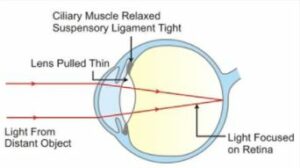
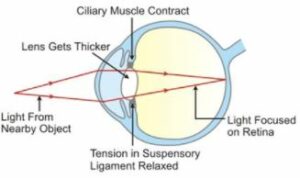
Question 6
By closing the eyes and gently pressing them with your palms, you may see some specs of brilliant light. How do you get this sensation while there is no light entering your eyes?
Answer 6
If we look at a bright object and then close our eyes, the sensation of light persists for a short period. This is known as persistence image or the after image. It lasts for one-tenth of a second. Therefore by closing the eyes and gently pressing them with your palms, you see some specs of brilliant light.
Question 7
Answer 7
The three ear ossicles are: Malleus (hammer), Incus (anvil) and Stapes (stirr up).
The last ear ossicle, stapes, vibrates and transmits the vibration to the oval window.
The role of other two ear ossicles is to magnify the vibration of stapes as a result of their lever like action.
Chapter-11, Sense Organs “Selina Biology Solution for Class 10”
E. STRUCTURED/APPLICATION/SKILL TYPE
Page 150-151
Question 1
With reference to the functioning of the eye, answer the questions that follow:
(a) What is the shape of the lens during (1) near vision (2) distant?
(b) Name the two structures in the eye responsible for bringing about the change in the shape of the lens.
(c) Name the cells of the retina and their respective pigments which get activated (1) in the dark and (2) in the light.
Answer 1
(a) Shape of the eye:
- Near vision – flattened
- Distant – rounded or more convex
(b)Ciliary muscles and suspensory ligament
(c) In the dark: Cells – rod cells, Pigment – rhodopsin
In the light: Cells – cone cells, Pigment – iodopsin
Question 2
With reference to the human ear, answer the questions that follow:
(a) Given the technical term for the structure found in the inner ear.
(b) Name the part of the ear associated with (1) static balance (2) hearing (3) dynamic balance.
(c) Name the nerve, which transmits messages from the ear to the brain.
Answer 2
(a) The middle ear or membranous labyrinth has two structures inside it, the cochlea and the semi-circular canals.
(b) Static balance – Utriculus and sacculus (inner ear)
Hearing – Internal ear
Dynamic balance – Semi-circular canals (inner ear)
(c) Collectively they are termed as ossicles.
Question 3
The figure given below refers to the vertical section of the eye of a mammal. Study the figure carefully and answer the following questions.
(a) Label the guidelines shown as 1 to 10.
(b) Write one important role of parts shown as 3 and 7.
(c) Write one structural difference between the parts shown as 9 and 10.
(d) Mention one functional difference between the parts shown as 6 and 8.
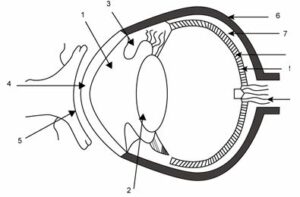
Answer 3
(a) Cornea is comparable to the lens cover of the camera.
The iris and pupil act like the aperture of a camera.
(b) The cornea is the eye’s main focusing element. It takes widely diverging rays of light and bends them through the pupil; the rays are further converged by the lens.
Question 4
Given below is a diagram depicting a defect of the human eye? Study the same and answer the questions that follow:
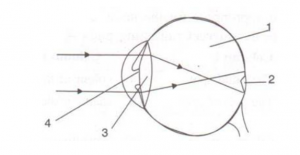
(a) Name the defect shown in the diagram.
(b) Give two possible reasons for this defect.
(c) Name the parts labeled 1 to 4.
(d) Name the type of lens used to correct this eye defect.
(e) Draw a labeled diagram to show how the above mentioned defect is rectified using the lens named above.
Answer 4
(a) Myopia
(b) The two possible reasons for myopia are either the eye ball is lengthened from front to back or the lens is too curved.
(c) 1 – vitreous humour, 2 – blind spot, 3-lens, 4-pupil
(d) Concave lens
(e)
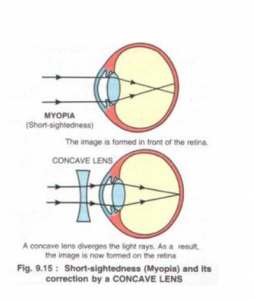
Question 5
The figure below is the sectional view of a part of the skull showing a sense organ:
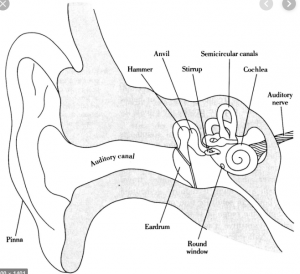
(i) Name the sense organ.
(ii) What are the parts labeled ‘m’, ‘i’ and ‘s’? What do these parts constitute collectively?
(iii) What do you call the part shown in the form of a spiral? What is its function?
(iv) Name the part labeled ‘tm’. What is its function?
Answer 5
(i) Ear
(ii) m – malleus, i – incus and s – stapes respectively. These are collectively called as ear ossicles.
(iii) Cochlea. The vibrating movements in the hair of the sense cells of cochlea transmit the impulse for hearing to the brain via auditory nerve.
(iv) Tympanic membrane. It vibrates and then sets the ear ossicles into vibration in the process of hearing.
Question 6
Given below is a diagram of a part of the human ear. Study the same and answer the questions that follow:
(i) Give the collective biological term for Malleus, Incus and Stapes.
(ii) Name the parts labeled A, B and C in the diagram.
(iii) State the functions of the parts labeled ‘A’ and ‘B’.
(iv) Name the audio receptor region present in the part labeled ‘A’.
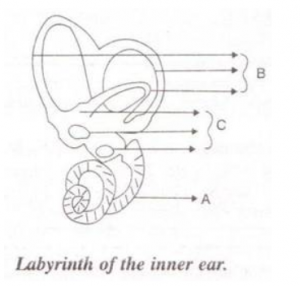
Answer 6
(i) Ear ossicles
(ii) A – Cochlea, B – Semicircular canals, C – Ear ossicles
(iii) Cochlea helps in transmitting impulses to the brain via the auditory nerve. Semicircular canals help in maintaining dynamic equilibrium of the body.
(iv) Organ of Corti
Question 7
Draw a labeled diagram of the inner ear. Name the part of the inner ear that is responsible for static balance in human beings.
Answer 7
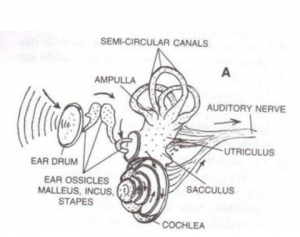
Utriculus and Saccules are responsible for maintaining static balance in human beings.
Question 8
Have a look at the posture of this woman who is reading a book and answer the questions which follow:
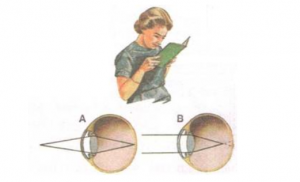
(a) Name the problem she is facing.
(b) What are the two conditions shown in sections A and B of the eye as applicable to her?
(c) What kind of looking glasses she needs?
Answer 8
(a) Myopia
(b) A-Normal eye, B-Myopia
(c) Looking glasses with the concave lens are required here.
Question 9
The figure given below shows the principal parts of a human ear. Study the diagram and answer the following questions.
(a) Label the parts 1 to 8.
(b) State the role of parts 6, 7 and 8.
(c) Why is it harmful to use a sharp object to remove ear wax? Mention the number and name of the part involved.
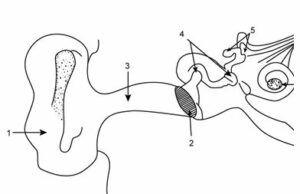
Answer 9
(a)
1 – External ear (pinna),
2 – Ear drum (tympanum),
3 – Auditory canal,
4 – Malleus,
5 – Semicircular canals,
6 – Cochlea,
7 – Auditory nerve,
8 – Eustachian tube.
(b)
Part 6 (Cochlea) – It contains sensory cells for hearing.
Part 7 (Auditory nerve) – It transmits impulse of hearing to the brain.
Part 8 (Eustachian tube) – It equalizes air pressure on both the sides of the tympanum.
(c) It is harmful to use a sharp object to remove ear wax as it can rupture the ear drum.
The part involved is part 2 – Ear drum (tympanum).
Return to Concise Selina ICSE Biology Class-10
Thanks
